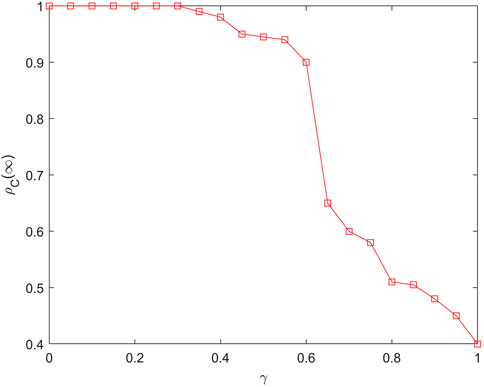- 1School of Business Administration, Shanghai Lixin University of Accounting and Finance, Shanghai, China
- 2School of Management, Jiangsu University, Zhenjiang, Jiangsu, China
- 3School of Finance and Economics, Jiangsu University, Zhenjiang, Jiangsu, China
The increasing uncertainty in the socio-economic landscape has heightened management’s interest in and expectations for employees’ opinions and suggestions. Concurrently, employee silence behavior is pervasive in today’s corporate world, prompting widespread academic attention. This study employs the dynamic evolutionary game approach to further examine the impact of differential leadership on employee silence of both insiders and outsiders and underlying mechanisms, with a focus on the Chinese socio-economic context. The research findings reveal that both insiders and outsiders may exhibit non-silent behaviors to gain their leaders’ attention and favor, ultimately achieving and sustaining benefit-seeking. Psychological empowerment and out-group preference emerge as key drivers of non-silent behaviors for internal and external employees, respectively. Based on the theories of psychology and social network, this research enriches the theory system of differential leadership behavior evolution and makes up for the deficiency of management in depicting the dynamic process of differential leadership behavior evolution, it provides a theoretical basis for grasping the evolution of differential leadership behavior and its rules of action. The investigation not only supplements and broadens the scope of relevant empirical research but also offers a theoretical foundation for analyzing and comprehending the evolution of differential leadership behavior and its consequences.
1 Introduction
Amid China’s economic and social transformation, businesses face mounting competitive pressures and struggle to survive and develop. Employees’ opinions and suggestions have become crucial reference points for organizational decision-making ([1] [2]). In the current Chinese market, instances of self-deception, akin to ‘the emperor’s new clothes’, are prevalent. As vital components of corporate management, employees possess access to crucial information and can identify weaknesses and potential crises in management practices [3,4]. However, due to various external pressures, they often opt to express their views silently, that means, they will passively conceal opinions due to worry about causing disputes. Studies have shown that employees’ silent behavior may negatively impact their emotional communication, interpersonal interactions, and the quality of decisions made by corporate management.
Influenced by traditional Chinese ‘circle’ culture, a ripple-like network of relationships often forms within organizations, with the leader at the core and spreading outward in a differential pattern, giving rise to the differential leadership style [5,6]. Game theory and complex network theory are widely used in the research of social sciences and behavioral communication [7–10]. Scholars have primarily explored the internal developmental rules of differential leadership behavior evolution from sociology, management, and psychology perspectives. However, the limitations of these perspectives have yielded relatively one-sided research results, and differing research angles have led to ambiguities among findings. This study enriches the theoretical framework of differential leadership behavior evolution by integrating psychological and social network perspectives and addressing the gap in management science regarding the dynamic process of differential leadership behavior evolution [11,12]. Numerous studies have examined the relationship between differential leadership and employees’ silent behavior in domestic family businesses1 [13].
This research further investigates differential leadership from the perspective of interactions between insiders and outsiders by using a dynamic game approach to study the influence of various employee types on silent behavior based on perceived benefits. As representatives of the organization (team) and decision-makers, differential leaders create an artificial division between insiders and outsiders [14–17]. In this context, both groups must strive to pursue their best interests. Insiders’ interests mainly lie in maintaining their status and a favorable impression within the leader’s group, while outsiders’ interests involve gains, performance levels, and group mobility based on out-group preferences. Consequently, employee mobility in a family business involves both insiders and outsiders and requires a dynamic game of behavior based on perceived benefits to maintain insiders’ status or gain such status. Hence, in the Chinese context, employing an evolutionary game approach to study the impact of differential leadership on employee silence and its mechanisms is a valuable complement and extension to relevant empirical research, bearing significant theoretical and practical implications.
2 Game model description
This study employs a simplified version of the prisoner’s dilemma game to capture the impact of differential leadership on employees’ non-silent behavior. It assumes that participants engaged in non-silent behavior are insiders and outsiders, with the leader’s classification of these groups aligning with the employees’ self-perceptions. Generally, individual i calculates their overall payoff after playing round t using Eq. 1, as illustrated below:
P and R represent the gains from non-silent or silent behavior of all participants in the game, respectively. S and T symbolize the gains from the different behavioral choices of insiders and outsiders participating in the game, resulting in non-silent and silent behavior of employees, respectively. If si = 1, individual i employs a non-silent strategy; if si = −1, individual i uses a silent strategy, ∂i denotes the neighbors’ set of i.
Under the assumption of imperfect information symmetry, all participants in the game are considered rational economic agents who seek to maximize their interests during their status mobility. However, their interests may not be fully aligned. Additionally, it is challenging for insiders and outsiders to possess a comprehensive understanding of each other, even after working together for an extended period. Thus, the requirement for complete information is not fully met. Consequently, we define CIA(t), CIS(t), COA(t), and COS(t) as follows:
where CIA(t) and CIS(t) represent the combined benefits arising from the non-silent and silent behavior of insider employees involved in the game, respectively. Similarly, COA(t) and COS(t) denote the combined payoffs arising from the non-silent and silent behaviors of outsider employees involved in the game, respectively. The payoff spaces for the different behavioral strategies chosen by insiders and outsiders are St1 and St2, respectively. Moreover, β signifies the degree of bias in the leader’s treatment of outsiders, and U(t) represents the earnings gap between insiders and outsiders due to the leader’s differential treatment of employees.
The actual psychological capital held, as represented by self-efficacy, and the desired psychological capital held, as represented by out-group preference, result in employees performing the same non-silent behavior but not receiving the same benefits. This discrepancy is particularly evident in the analysis of perceived benefits. This study assumes that the actions of the two parties in the game are sequential, and the later actors can observe the actions of the preceding actor and infer the probability distribution based on those actions. Consequently, this study develops a dynamic game model with bivariate incomplete information. As a result, there is a difference between an individual’s perceived benefits and their actual benefits. Based on weighting effects, this study defines the perceived benefits of individual i as follows:
where
Based on the above assumptions, and supported by numerous empirical studies demonstrating that work engagement is positively related to employee performance ([18]; [19]), this study establishes a model using relevant variables. The parameters and specific meanings of these variables are shown in Eq. 4: φIA and φIS represent the perceived benefits resulting from non-silent and silent behavior of insiders participating in the game, respectively (φIA > φIS). Similarly, φOA and φOS denote the perceived benefits resulting from non-silent and silent behavior of outsiders participating in the game, respectively. As a result, outsider employees’ performance is positively related to the cost of their input.
Individuals adjust their strategies based on their own subjective rewards and those of their colleagues [20]. First, employee i, with a behavioral strategy, randomly selects colleague j, who also has a behavioral strategy, to compare the behavior and its perceived benefits. Second, employee i decides whether to adopt employee j’s behavioral strategy. This study applies Fermi rule to the probability of individuals choosing colleague j’s behavioral strategy in a probabilistic simulation:
where φi and φj represent the combined psychological benefits of employee i and employee j, respectively. This corresponds to the κ value for inverse temperature, providing a measure of the intensity of natural selection in this study. Without loss of generality, this study sets the value of κ = 0.1. This implies that better-performing employees are more likely to pass on their strategies to other colleagues, but employees may occasionally learn behavioral strategies from less successful colleagues [21].
3 Simulation and results
The relationship network structure is assumed to be a BA scale-free network with N = 103 employees. The degree distribution follows p(k) ∼ k−α, with α = 2.1. Monte Carlo methods are employed to implement the differential leadership game model. Let ρC(t) denote the proportion of employees who choose silent behavior after t game rounds, and ρC(∞) represent the proportion of employees who choose silent behavior in the steady state. The results of each simulation are obtained by averaging 100 independent runs to mitigate random effects.
Figure 1 displays the change in the proportion of employees choosing silent behavior. The proportion of employees choosing silent behavior decreases sharply as the game cycle progresses. Possible reasons for these results include the greater degree of heterogeneity in the structure of scale-free networks, which allows employees to access a wider range of information sources. Employees can receive information about other organization members from different nodes and judge the psychological benefits gained from silent or non-silent behavior by other organization members, adjusting their behavioral strategies accordingly [22,23]. Additionally, some nodes in a scale-free network have a large degree and can be considered leader nodes, effectively promoting non-silent behavior.
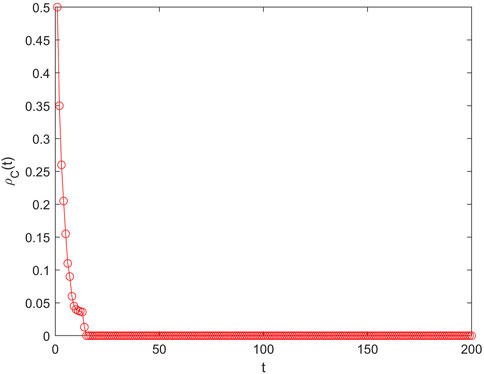
FIGURE 1. The proportion of employees choosing silent behavior falls sharply as the game cycle t progress.
Figure 2 illustrates the relationship between the proportion of employees who choose silent behavior and the desired benefit S. In general, the psychological benefits of employees who choose non-silent behavior are positively related to the expected benefits S. This encourages employees who initially choose silent behavior to switch to non-silent behavior to obtain the expected benefits S. Consequently, the proportion of employees choosing silent behavior A exhibits a significant negative correlation with the value of the expected benefit S. The greater the psychological benefit for employees choosing non-silent behavior, the smaller the proportion of employees opting for silent behavior.
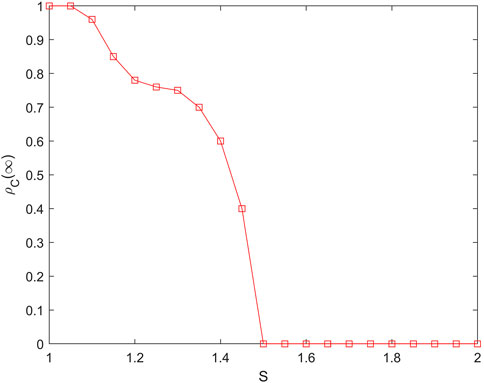
FIGURE 2. Proportion of employees who choose silent behavior decreases with increasing expected benefit S.
Figure 3 presents the change in the proportion ρc(∞) of employees choosing silent behavior as the proactive personality coefficient γ varies. The proportion of employees choosing silent behavior gradually decreases as the proactive personality coefficient γ increases. The proactive personality factor γ reflects, to some extent, an individual’s willingness to pursue rewards. As the proactive personality factor γ rises, the proportion of employees choosing silent behavior ρc(∞) declines, since employees tend to proactively change their behavior strategies in pursuit of higher returns on benefits.
In an external environment filled with uncertainty, employees’ actual and perceived benefits can be influenced by numerous factors. In this study,
ϕIA(t) and ϕIS(t) represent the average real benefits resulting from non-silent and silent behavior by insiders participating in the game, respectively. Similarly, ϕOA(t) and ϕOS(t) denote the average real benefits resulting from non-silent and silent behavior by outsiders participating in the game, respectively.
Furthermore, this study establishes the average perceived benefits for the different types of employees practicing various behavioral strategies as follows:
ψIA(t) and ψIS(t) represent the average perceived benefits resulting from non-silent and silent behavior by insiders participating in the game, respectively. Similarly, ψOA(t) and ψOS(t) denote the average perceived benefits resulting from non-silent and silent behavior by outsiders participating in the game, respectively.
As previously mentioned, the non-silent behavior of insiders is motivated by self-efficacy and the pursuit of higher benefits based on the actual possession of psychological capital. In contrast, the non-silent behavior of outsider employees is driven by the preference of the outside group and the desire to hold psychological capital to develop positive behavioral orientations [26]. Consequently, both situations can result in different benefits for employees who perform non-silent behaviors in terms of actual and perceived benefits.
Figure 4 illustrates the change in psychological perceived gains for individuals choosing silent versus non-silent behavior. Comparing Figures 4A, B reveals that as the number of game rounds increases, the psychological gains of employees adopting silent behavior decrease, while the perceived gains of employees adopting non-silent behavior gradually increase. Therefore, the perceived benefits of non-silent behavior increase, suggesting that employees who adopt silent behavior can maximize their rewards by altering their behavioral strategies.
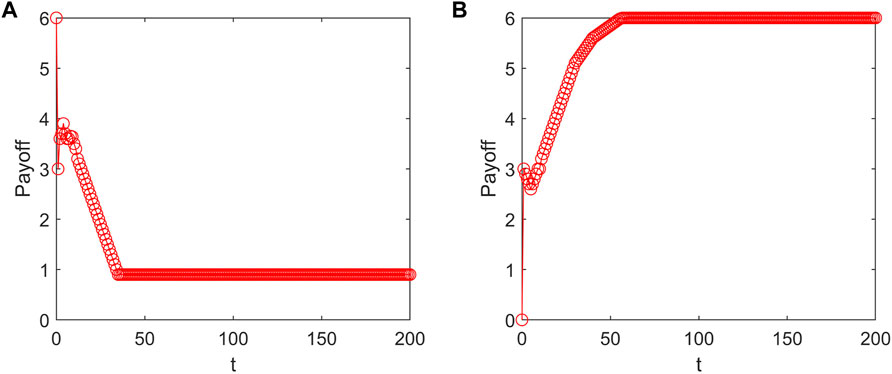
FIGURE 4. (A) Perceives benefits of employees choosing silent behavior decreases with t, and (B) perceives benefits of employees choosing non-silent behavior increases with t.
We further investigate the impact of expected gain S and proactive personality coefficient γ on employees’ perceived psychological gains when adopting silent or non-silent behavior, as depicted in Figure 5. As the proactive personality factor γ increases, the perceived benefits rise for both silent and non-silent employees. With a growth in the proactive personality factor γ, and in line with the previous analysis, employees’ passivity diminishes, leading to a propensity for proactively changing strategy choices in pursuit of higher reward benefits. This, in turn, enhances the perceived psychological benefits for employees. Simultaneously, as the desired benefit S escalates, the perceived psychological benefit for employees adopting non-silent behavior strategies will expand, while the perceived psychological benefit for employees adopting silent behavior strategies will decline. As the expected benefit S increases, the perceived psychological benefits of non-silent actions will significantly rise, whereas the psychological benefits of employees adopting silent behavior strategies will substantially decrease. In this scenario, employees who adopt the silent behavior strategy will modify their behavior and attempt to gain more by engaging in non-silent behavior.
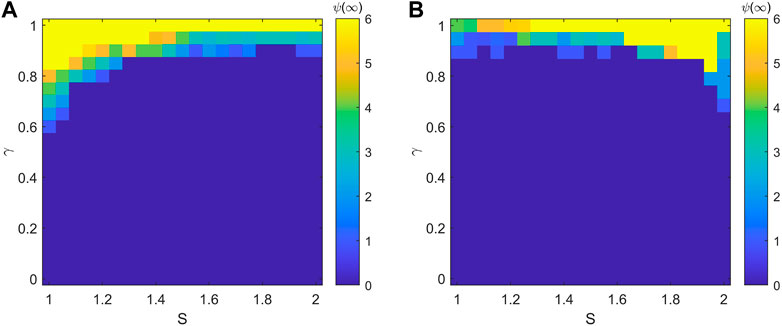
FIGURE 5. (A) Perceives benefits of employees choosing silent behavior increase with the proactive personality factor γ and decrease with the desired benefit S, and (B) perceives benefits of employees choosing non-silent behavior increase with the proactive personality coefficient γ and increase with the desired benefit S.
4 Conclusion
Employee non-silent behavior is a complex interplay involving both insiders and outsiders. The dynamic game analysis presented earlier illustrates that to attain optimal levels of perceived benefits and fulfill their interests, insiders and outsiders must engage in non-silent actions. As two distinct subjects in this game, leaders artificially categorize them into insiders and outsiders due to the influences of traditional culture and the social structure of a differential pattern. Consequently, both groups need to secure the leader’s favor through non-silent behavior.
Perceived psychological benefits drive employees’ non-silent behavior. As shown in the game analysis, perceived benefits generally decline when employees opt for silent behavior, while they increase when employees choose non-silent behavior. Both insiders and outsiders will only exhibit non-silent behavior if they believe it will enhance perceived benefits and that silent behavior will diminish them. For outsider employees, there is a significant difference in perceived benefits compared to insiders. This suggests that, in differential leadership contexts, achieving non-silent behavior for outsiders is a challenging process requiring leader support, prompting them to invest more resources and effort for their status mobility.
The essence of varying perceived benefits reflects the psychological state of the employee. Self-efficacy motivates non-silent behavior in insiders, who seek higher benefits in response to their current mindset and possess psychological capital. This can lead to increased levels of perceived benefits that resonate with self-efficacy. In contrast, outsiders develop non-silent behaviors driven by outgroup preference, aspiring to transform their current disadvantage into future gains. They will inevitably have lower perceived benefits than insider employees motivated by the desire to maintain psychological capital. Thus, the actual psychological capital held (represented by self-efficacy) and the desired psychological capital held (represented by outgroup preference) result in employees exhibiting the same non-silent behavior but experiencing different combined benefits, especially in terms of perceived psychological benefits.
A proactive personality significantly influences perceived gains and non-silent behavior for both insiders and outsiders. In a dynamic leadership environment, these groups experience a constantly changing status landscape. For insider employees, leaders offer allowances and reassurances to gain their support, which in turn enhances their psychological empowerment and non-silent behavior. If they also possess a highly proactive personality, they will actively pursue opportunities to boost perceived gains and engage in non-silent behaviors to solidify their position and satisfy their interests. For outsider employees, attaining status mobility is time-consuming and costly, meaning that performance improvement is directly proportional to the effort invested. Therefore, with a proactive personality, outsider employees are more likely to take the initiative in demonstrating pro-organizational behaviors. As work engagement positively correlates with employee performance, perceived benefits for outsider employees increase, ultimately leading to heightened non-silent behaviors.
5 Summary
This study employs a dynamic game approach to analyze scenarios with incomplete information for insiders and outsiders. By examining the dynamics of perceived benefits for all employees and exploring the impact of insider and outsider status on non-silent or silent behavior, the study reveals that both groups need to exhibit non-silent behavior to secure the attention and favor of the leader, ultimately achieving and preserving their desired benefits. The psychological empowerment of insiders and the out-group preference of outsiders act as essential drivers for their non-silent behavior. The independent and collaborative roles of insiders and outsiders contribute to fostering a positive organizational climate. The efforts invested by each group result in considerable perceived benefits and significantly influence the enhancement of performance gains through constructive behavioral processes.
Data availability statement
The original contributions presented in the study are included in the article/Supplementary material, further inquiries can be directed to the corresponding author.
Author contributions
All authors listed have made a substantial, direct, and intellectual contribution to the work and approved it for publication.
Funding
This research was supported by the Humanities and Social Sciences Fund of the Ministry of Education China (18YJA630074), the National Social Science Fund (19BGL127), and the National Natural Science Fund (72072076).
Conflict of interest
The authors declare that the research was conducted in the absence of any commercial or financial relationships that could be construed as a potential conflict of interest.
Publisher’s note
All claims expressed in this article are solely those of the authors and do not necessarily represent those of their affiliated organizations, or those of the publisher, the editors and the reviewers. Any product that may be evaluated in this article, or claim that may be made by its manufacturer, is not guaranteed or endorsed by the publisher.
Footnotes
1Differential leadership is a relatively special leadership in Chinese organization especially in Chinese family enterprises. In Chinese enterprises, the principle of “closeness and distance” of leaders affects the allocation of resources and forms an organizational atmosphere that attaches importance to the rule of man. The interpersonal interaction among Chinese people mostly depends on the relationship between relatives, distance and status, and the differential leadership formed by this will have obvious differences in the distribution of employees’ interests, behavior, and emotions. So, there are lots of research about differential leadership and its economic consequences in domestic family businesses.
References
1. Philip MP, Dennis O. Self-reports in organizational research: Problems and prospects. J Manage (1986) 12:531–44.
2. Bandura A, Caprara GV, Barbaranelli C, Gerbino M, Pastorelli C. Role of affective self-regulatory efficacy in diverse spheres of psychosocial functioning. Child Dev (2003) 74:769–82. doi:10.1111/1467-8624.00567
3. Dahling JJ, Chau SL, Mayer DM, Gregory JB. Breaking rules for the right reasons? An investigation of pro-social rule breaking. J Organizational Behav (2010) 33:21–42. doi:10.1002/job.730
4. Hussak LJ, Cimpian A. An early-emerging explanatory heuristic promotes support for the status quo. J Personal Soc Psychol (2015) 109:739–52. doi:10.1037/pspa0000033
5. Li AN, Liao H. How do leader–member exchange quality and differentiation affect performance in teams? An integrated multilevel dual process model. J Appl Psychol (2014) 99:847–66. doi:10.1037/a0037233
6. Durand R, Pierre-Antoine KP. Classical deviation: Organizational and individual status as antecedents of conformity. Acad Manage J (2016) 59:65–89. doi:10.5465/amj.2013.0767
7. Zeng ZY, Li YH, Feng MY. The spatial inheritance enhances cooperation in weak prisoner’s dilemmas with agents’ exponential lifespan. Physica A (2022) 593:126968. doi:10.1016/j.physa.2022.126968
8. Yao YC, Pi B, Zeng ZY, Feng MY. Protection and improvement of indirect identity cognition on the spatial evolution of cooperation. Acad Manage J (2023) 620:128791. doi:10.1016/j.physa.2023.128791
9. Pi B, Zeng ZY, Feng MY, Kurths J. Evolutionary multigame with conformists and profiteers based on dynamic complex networks. Chaos (2022) 32:023117. doi:10.1063/5.0081954
10. Zhang LB, Guo C, Feng MY. Effect of local and global information on the dynamical interplay between awareness and epidemic transmission in multiplex networks. Chaos (2022) 32:083138. doi:10.1063/5.0092464
11. Knippenberg DV. Embodying who we are: Leader group prototypicality and leadership effectiveness. Leadersh Q (2011) 22:1078–91. doi:10.1016/j.leaqua.2011.09.004
12. Zheng XM, Qin X, Liu X, Liao H. Will creative employees always make trouble? Investigating the roles of moral identity and moral disengagement. J Business Ethics (2019) 157:653–72. doi:10.1007/s10551-017-3683-3
13. Kraiczy ND, Hack A, Kellermanns FW. What makes a family firm innovative? Ceo risk-taking propensity and the organizational context of family firms. J Prod Innovation Manage (2015) 32:334–48. doi:10.1111/jpim.12203
14. Zagenczyk TJ, Purvis RL, Cruz KS, Thoroughgood CN, Sawyer KB. Context and social exchange: Perceived ethical climate strengthens the relationships between perceived organizational support and organizational identification and commitment. Int J Hum Resource Manage (2020) 32:4752–71. doi:10.1080/09585192.2019.1706618
15. Wu MY, Zhang LR, Imran M, Xu J, Yu R. Impact of differential leadership on innovative behavior of employees: A double-edged sword. Soc Behav Personal (2021) 1–12:1–12. doi:10.2224/sbp.9746
16. Cai SC, Zhou LF. Scale construction for identifying the relationship between leaders and employees. Chin J Psychol (2020) 359–90.
17. Wu SJ, Gao WC, Quan Y. The influence of differential leadership and creative self-efficacy on employees’ creativity: Moderating effect of zhong-yong thinking. Sci Technol Prog Pol (2021) 144–51.
18. Brown SP, Leigh TW. A new look at psychological climate and its relationship to job involvement, effort, and performance. J Appl Psychol (1996) 81:358–68. doi:10.1037/0021-9010.81.4.358
19. Jin YX. The impact of employee’s positive coping with organizational change and work engagement on employee performance: The moderating role of skill. Sci Sci Manage S.& T (2016) 37:158–71.
20. Wang YF, Liu JQ, Zhu Y. How does humble leadership promote follower creativity? The roles of psychological capital and growth need strength. Leadersh Organ Develop J (2018) 39:507–21. doi:10.1108/lodj-03-2017-0069
21. Kim H, Callan MJ, Gheorghiu AI, Matthews WJ. Social comparison, personal relative deprivation, and materialism. Br J Soc Psychol (2017) 56:373–92. doi:10.1111/bjso.12176
22. Umphress EE, Bingham JB, Mitchell MS. Unethical behavior in the name of the company: The moderating effect of organizational identification and positive reciprocity beliefs on unethical pro-organizational behavior. J Appl Psychol (2010) 95:769–80. doi:10.1037/a0019214
23. Erixson O, Ohlsson H. Estate division: Equal sharing, exchange motives, and cinderella effects. J Popul Econ (2019) 32:1437–80. doi:10.1007/s00148-018-0727-7
24. Mclaughlin KA, Costello EJ, Leblanc W, Sampson NA, Kessler RC. Socioeconomic status and adolescent mental disorders. Am J Public Health (2012) 102:1742–50. doi:10.2105/ajph.2011.300477
25. Sen J, Pal DP. Changes in relative deprivation and social well-being. Int J Soc Econ (2013) 40:528–36. doi:10.1108/03068291311321839
Keywords: employee silence behavior, evolutionary game, differential leadership, psychological empowerment, out-group preference
Citation: Lu J, Chen Y, Xu Y and Zhu Y (2023) A game-theoretic analysis of the impact of differential leadership on employee silence behavior in family enterprises. Front. Phys. 11:1230161. doi: 10.3389/fphy.2023.1230161
Received: 28 May 2023; Accepted: 29 June 2023;
Published: 06 July 2023.
Edited by:
Libo Zhang, Southwest University, ChinaReviewed by:
Yunlong Yu, Nanjing University of Information Science and Technology, ChinaJianrong Wang, Shanxi University, China
Jianbo Wang, Southwest Petroleum University, China
Copyright © 2023 Lu, Chen, Xu and Zhu. This is an open-access article distributed under the terms of the Creative Commons Attribution License (CC BY). The use, distribution or reproduction in other forums is permitted, provided the original author(s) and the copyright owner(s) are credited and that the original publication in this journal is cited, in accordance with accepted academic practice. No use, distribution or reproduction is permitted which does not comply with these terms.
*Correspondence: Jie Lu, NjAzNTEzNTc1QHFxLmNvbQ==
 Jie Lu
Jie Lu Yanxia Chen2
Yanxia Chen2 Yuqing Zhu
Yuqing Zhu